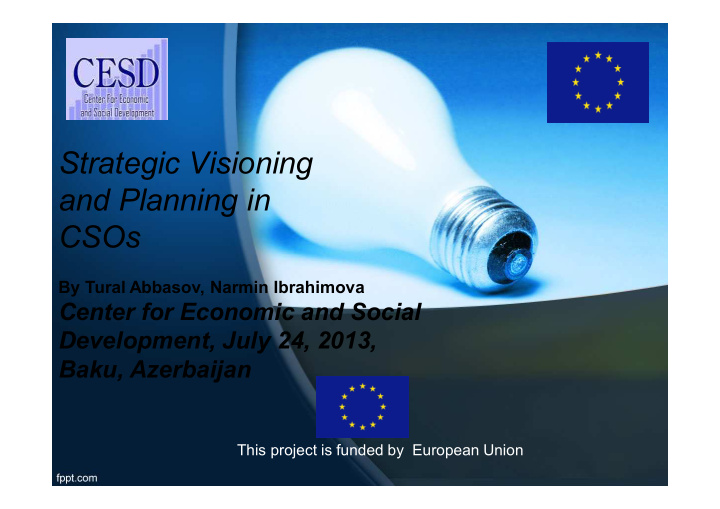



Strategic Visioning and Planning in CSOs By Tural Abbasov, Narmin Ibrahimova Center for Economic and Social Development, July 24, 2013, Baku, Azerbaijan This project is funded by European Union
Objectives • Critical Thinking Definition • Brief History of Critical Thinking • Critical Thinking v.s Creative Thinking • Common Critical Fallacies people make
Critical Thinking
What is critical thinking? • Critical thinking is a purposeful self- regulatory judgement, which manifest itself in giving reasoned consideration to the evidence, methods and conceptual structures within which a decision is made about what to believe or what to do.
Etymology • Critical-means crucial, • Second etymology derives from Greek word kritikos, which means discerning judgement
Why Critical Thinking is important? • React critically to an essay or to evidence presented in a textbook or on a website • Judge the quality of a lecture or speech • Form an argument • Write an essay based on a reading assignment • Participate in class
Socratic Questioning -Clarify Thinking (Why do you say that? Could you please explain more? ) -Clarification of Assumption (What can we assume?) -Basis for arguments (Why do you say that? Is there any important supporting evidence for that?) -Generating Alternatives (What is the counter argument?) -Consequences of ideas ( If that happens what is the consequence? Why do we have to care about that? -Questioning yourself (Why did I ask that question? Was it important on revealing the truth?)
Renaissance Francis Bacon Sir Thomas More Machiavelli
Creative Thinking vs Critical Thinking Critical Thinking Creative Thinking • Judgemental • Non-judgemental • Selective • Non-selective • Science, business • Poetry, novel
Six Thinking hats
Six Thinking hats Creativity, Information known new ideas Gut reaction, Brightness, feelings optimism Judgment- the devils Process control advocate
Fallacies Fallacy is a reasoning ‘’trick” that an author might use while trying to persuade you to accept a conclusion.
Ad hominem “Dear editor: I was shocked by your papers support of Senator Spendall’s argumets for a tax hike to increase state money available for improving highways. Of course the Senator favors such a hike. What else would you expect from a tax and spend liberal”
Slippery slope • Conclusion: Government should not prohibit alcohol/tobacoo advertising on radio and Televisions • Reason 1: if government prohibits advertising on radio and TVs, it will soon prohibit many kinds of advertising, because many products presents potential health hazards. • Reason 2: No action by the federal government can or will be effective in eliminating alcohol consumption
Appeal to popularity • Appeal to questionable authority: Supporting a conclusion by citing an authority who lacks special expertise on the issue at hand
Appeal to emotions • Appeal to emotions happens when our emotional reactions gets us to agree with a claim.
False Dilemma • False dilemma occurs when speaker treats controversies as if there is only to possible solutions. • Wishful thinking • Explaining by naming
Recommend
More recommend